INTRODUCTION
These five discs represent a treasurable co-production between CPO and Bavarian
Radio. CPO's achievements seem to attract scant comment. This is surprising
and disappointing when so much is made of the majors who have often shown
less enterprise than this 'small' German label.
Their catalogue seems to have been created with the express purpose of filling
gaps in the world's discographies. The repertoire ranges over a wide vista.
They may be compared with Lyrita who have done so much for British music.
However Lyrita's catalogue is smaller and new releases from them seem to
happen once every decade (if we are lucky) on an irregular drip-feed. CPO
keep issuing each month. Their catalogue is stable and easily available.
I am not sure if CPO ever issued LPs (I doubt it) but they seem to have been
a child of the CD era in which they have blossomed and flourished. Surprising
projects pour out from them in cornucopia abundance.
Pfitzner is certainly an old-fashioned composer (as if that mattered!). His
music is not far removed from Brahms and Schumann (he famously recorded the
Second Symphony) although a twentieth century sensibility is certainly at
work. Occasionally one can sense world events (and especially German ones)
at work in this music although often those written contemporaneously with
great tragic moments rarely (if ever) reflect tragedy. On the contrary they
often suggest a retreat from the world or at least a failure to see its relevance
to the world's tragedies.
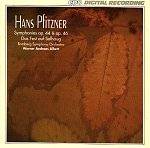 |
CD1
Kleine Symphonie in G major (1939)
Symphony in C major (1940)
Das Fest auf Solhaug - three preludes (1890)
Bamberg SO/Werner Andreas Albert.
rec Bavarian Radio, July 1989, Nov 1989, Feb 1990.
CPO 999 080-2 [57.00] |

Save around 22% with
Crotchet
Amazon
US |
The 1939 Little Symphony is in four movements: I Serenade-like with
a touch of Smetana about it; II a pert trumpet-goaded allegro; III a near
Mahlerian wallow of an adagio; IV a childlike village dance.
The Symphony for Large Orchestra (1940) opens with a commanding rolling
horn-spurred theme and proceeds through multiple helpings of Schumann and
Bruckner. If you can screen out the pompous moments (like 4.07) and concentrate
instead on the refreshing emulation of Mendelssohn (Italian and
Scotch symphonies), pass the outdoor sports festival atmosphere and
get as far as the imperious (Rhenish) horn calls of the finale you
will have heard a work of intermittently flaring flames.
The Ibsen-inspired Solhaug music is in three movements the first's
undemanding ebb and flow rises to some crashing climaxes and is followed
by the gentle dances of the peasantry in the second movement. The final section
runs the gamut from moody scene setting, to Dukas-like liveliness to a
clod-hopping dance.
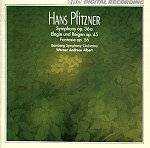 |
CD2
Symphony in C sharp minor (1932)
Elegie und Reigen (1939)
Fantasie (1947)
Bamberg SO/Werner Andreas Albert.
rec Bavarian Radio, Feb 1990, May 1991, Nov 1991, March 1992.
CPO 999 136-2 [66.31] |

Save around 22% with
Crotchet
Amazon
US |
This is easily the most impressive work in the collection indeed the whole
of this disc has a lot going for it. Clearly the early-mid 1930s were a vintage
time for Pfitzner (the best - and shortest - of his cello concertos dates
from that time). The symphony, which is an arrangement of the String Quartet
No. 3, launches off with a halting little tune. Moments of Mahlerian splendour
cross the scenery but are offset by some strangely Debussian moments. Searing
strings and an imperatively assertive tragic desperation which in the first
movement reaches back more than twenty years to Elgar's Second Symphony and
further in time to the Tchaikovsky of the late symphonies especially the
Pathétique. The second movement with its virtual quotes of
Beethoven 5 and 7 glistens with quirky fantasy. The following langsam
is glorious - Korngoldian without the multi-strata complexities. A
Prokofiev-style trumpet is also heard in this movement. The Finale is darting,
tense, almost American, in its heaven-spanning energy, cutting and crashing
through the textures. The work ends in satisfying tranquillity.
The Elegie prompts thoughts of Gerald Finzi's style especially the
long musing clarinet solo. This then transforms into a slatey Elgarian darkness.
Reigen is by contrast light jolly and a playground for swirling woodwind.
The Fantasie is a very late work in three movements of which the first
has elements of Mozartean style, Rachmaninov's gloom (Isle of the Dead)
and a great ponderous waltz which is the antithesis of the dance. The very
short second movement features Walter Forchert's solo violin - a soloist
who shone in the Koch recording of Reger's Symphonic Rhapsody. The
final movement's jerky fanfare reminded me a little of the brass dominated
march from Prokofiev's Love Of Three Oranges. It ends without conviction
or much sense of resolution.
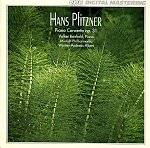 |
CD3
Piano Concerto in E flat major (1922)
Volker Banfield (piano)
Munich PO/Werner Andreas Albert.
rec Bavarian Radio, Nov 1982.
CPO999 045-2 [37.50]
ANALOGUE (all the others are digital) |

Save around 22% with
Crotchet
Amazon UK
Amazon
US |
Pfitzner's voice often drifts into areas we may easily take as allusions
to the most unexpected people. The opening of the piano concerto is pretty
rugged and its fulsome romance is close to that of Rachmaninov - the last
person I would have expected. The wings of the concerto are as the notes
candidly point out somewhat clipped in this recording. The Marco Polo in
which the soloist is Wolf Harden is similarly shorn of its full length. There
is still room for a full length recording. Some critics have suggested Schumann
as a reference point but for me (if we need references - and they are always
useful in unfamiliar music) - the voices of both Brahms (Second Piano Concerto)
and Mendelssohn come together in this Pfitzner work. Despite being the oldest
of the recordings here the sound is very respectable.
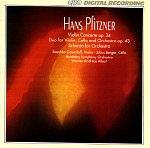 |
CD4
Violin Concerto in B minor (1924)
Duo for violin, cello and orchestra (1937)
Scherzo in C minor. (1888)
Saschko Gawriloff (violin)
Julius Berger (vc);
Bamberg SO/Werner Andreas Albert.
Rec Nov 1989, Feb 1990
CPO999 079-2: [63 minutes] |

Save around 22% with
Crotchet
Amazon
US |
The Violin Concerto seems to be extremely well played (I have not been able
to trace comparative performances - Gawriloff is however a seriously dedicated
violinist) has quite a few orchestral coups de theatres with a miniature
central movement (of three) for orchestra alone, a rather charming Mendelssohnian
accent and some striking effects in choosing orchestral 'spice' against which
the soloist is to play. The Duo has charm a plenty and is well worth hearing
without being utterly memorable. As with all these discs the recording quality
is never less than respectable.
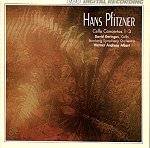 |
CD5
Cello Concerto in A minor (1888)
Cello Concerto in G major (1935)
Cello Concerto in A minor (1943)
David Geringas (vc)
Bamberg SO/Werner Andreas Albert.
Rec Nov 1992
CPO 999 135-2 [60.00] |

Save around 22% with
Crotchet
Amazon
US |
Three compact cello concertos in one hour.
The 1888 work (25 mins) is, as expected, strongly Brahmsian, sporting a dewy
brightness, flute highlights and a super-Mendelssohnian rush of strings at
8:50. It is not however as impressive a work as the notes imply.
The 1935 Concerto was written for Cassado and plays for just short of quarter
of an hour. It is a work of high-water wonder and extraordinary richness
and delight. There is a Chopin-like quality to the music and the accompaniment
in the orchestra often has a fluttering Delian quality. At 6.13 there is
a tolling song for the trumpets. Hollywood's 'hearts and flowers' sentimentality
occasionally invades this work but does nothing to dampen its irresistible
quality. Highly recommended.
The 1945 work is characteristic of the times: melancholy and typifying the
work of Brahms and Bruch. The work sports cello and clarinet duos, a lively
choppiness, peaceful repose and finally an insensitively hearty finale with
one passage of congruous velveteen huskiness from the solo instrument.
CONCLUSIONS
This set parallels, in significance, the weighty LP set of the Pfitzner chamber
music released by a German company (I forget which - Da Camera Magna?; anyone
care to remind me) in the late 1970s. A set of some significance (only 3
of the 5 discs were ever reviewed in Gramophone!) and not at all short of
enjoyment quotient.
If the music is occasionally ponderous you can set against this Pfitzner's
evident dedication to beauty and drama.
If you cannot stretch to the reduced price for all five discs then certainly
seek out the cello concertos, violin concerto and the 1932 symphony. There
is much to enjoy in this set. All of this music is worth exploring although
as indicated above the music does contain a few misfires.
Reviewer
Rob Barnett

|
